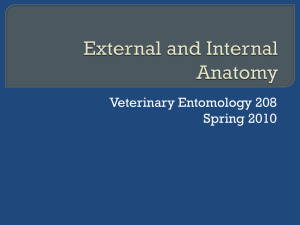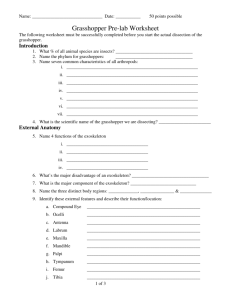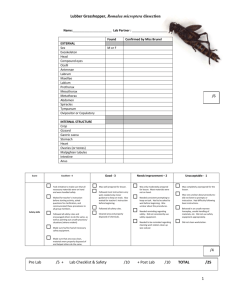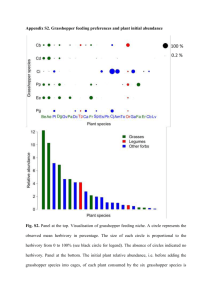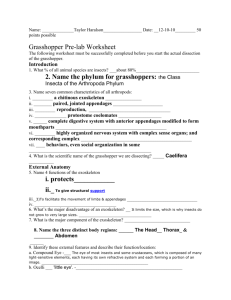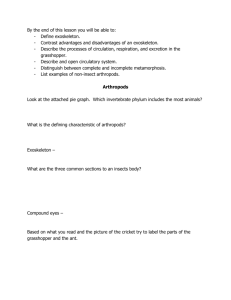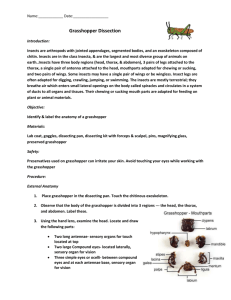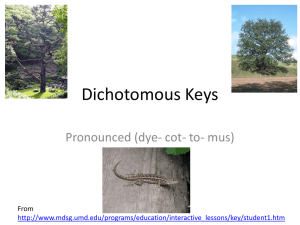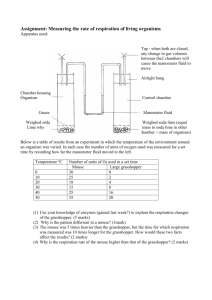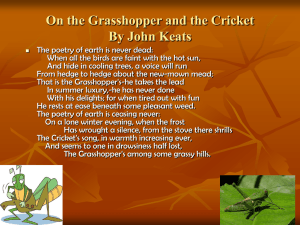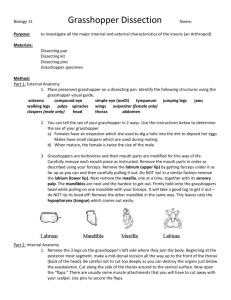Name: Date: The Grasshopper: External and Internal Anatomy
advertisement
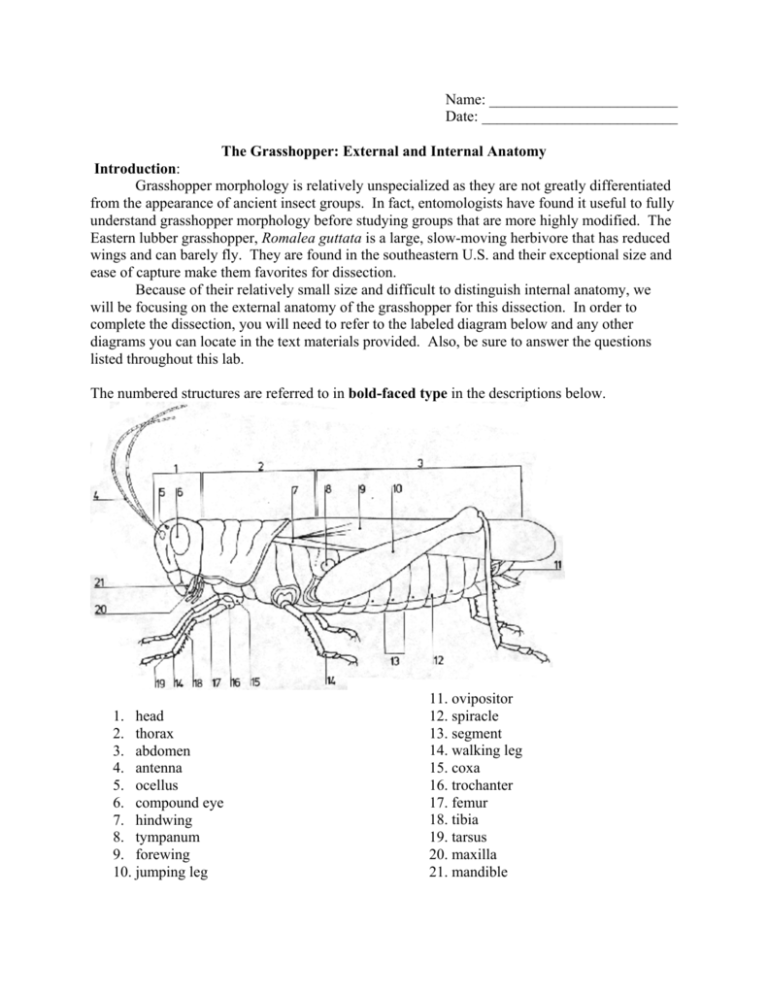
Name: _________________________ Date: __________________________ The Grasshopper: External and Internal Anatomy Introduction: Grasshopper morphology is relatively unspecialized as they are not greatly differentiated from the appearance of ancient insect groups. In fact, entomologists have found it useful to fully understand grasshopper morphology before studying groups that are more highly modified. The Eastern lubber grasshopper, Romalea guttata is a large, slow-moving herbivore that has reduced wings and can barely fly. They are found in the southeastern U.S. and their exceptional size and ease of capture make them favorites for dissection. Because of their relatively small size and difficult to distinguish internal anatomy, we will be focusing on the external anatomy of the grasshopper for this dissection. In order to complete the dissection, you will need to refer to the labeled diagram below and any other diagrams you can locate in the text materials provided. Also, be sure to answer the questions listed throughout this lab. The numbered structures are referred to in bold-faced type in the descriptions below. 1. head 2. thorax 3. abdomen 4. antenna 5. ocellus 6. compound eye 7. hindwing 8. tympanum 9. forewing 10. jumping leg 11. ovipositor 12. spiracle 13. segment 14. walking leg 15. coxa 16. trochanter 17. femur 18. tibia 19. tarsus 20. maxilla 21. mandible Dissection: 1. Get a lubber grasshopper from your instructor. Wash the grasshopper off under the sink and put in a pan. 2. Examine the external anatomy of the grasshopper. Distinguish between the head, thorax, and abdomen. Then look at the wings. The front wings are thickened into a tegmen and function to protect the membranous hind wings. Note how the wings are attached so that they can pivot and fold over the back. Question #1 How might the adaptation of wings that fold backwards be explained from an evolutionary perspective? In other words, what might be the advantage of having wings that fold? Remove the wings so you can continue dissection. 3. Next examine the head, which is composed of several fused plates called sclerites including the frons, clypeus, and gena that compose the head capsule. Locate the ocellus (simple eye), compound eye, and antenna. 4. Look at the mouthparts. Use a probe and handlens to examine the mouthparts including the labrum, mandibles, maxillae, and labium. Question #2 What is the function of these parts? 5. Cut open the tough head capsule and look for the brain and examine the internal support structures. 6. Remove a leg and identify the segments: coxa, trochanter, femur, tibia, and tarsus. 7. Locate the thoracic spiracles, which are the openings to the tracheal system. Question #3 What is the function of the tracheal system? 8. Look at the abdomen and locate the abdominal spiracles. 8. Place the grasshopper right side up and carefully cut through the exoskeleton with your scissors. Place some water in your dissecting tray, which will help float the organs, particularly the trachea which will look like a mass of branched silvery tubes. If you are careful you will see the heart, which is a dorsal tube, often it gets removed with the exoskeleton. Notice the many muscles that are attached to the exoskeleton, try to follow some and discern their purpose. Question #4 Describe the location and proposed purpose of one of the muscles you located. 9. Locate the digestive system. If your grasshopper is female everything may be covered with a large yellow mass of ovaries, follow them back to the ovipositor. Then push the ovaries aside and look for the gut. The esophagus leads from the mouth to the crop which functions to store food. Under the esophagus you may be able to see very small grayish grape-like clusters of the salivary glands. This leads to the gizzard and to the stomach. Just posterior to the gizzard, find the fingerlike projections called the gastric caeca. They are attached at the junction between the gizzard and the stomach. Follow the gut back to the hindgut where the very slender malpighian tubules, are attached. These act as a kind of kidney for removing nitrogenous wastes in insects. Question #5 Which is larger, the gizzard or the stomach? Question #6 In which one do you think food remains the longest? Why do you think this? 10. Remove the digestive system and look for the ventral nerve chord and the ganglia this will appear as two white lines along the inside of the sternum which are periodically connected with larger white masses. Question #7 Which characteristics make the grasshopper well adapted for its life on dry land?
